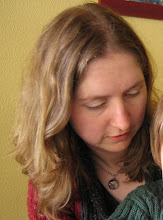On 29 June 2001, I caught a bus headed for Oswiecim, from Krakow central train station early in the morning. It was a gorgeous sunny morning and the driver had the radio on. The song I remember is 'Karma Chameleon' by Culture Club.
It turned out to be a very hot, bright day, and I wished I had a hat because we did a lot of walking outside. The weather was kind of shocking, in contrast to the bleak pictures in my mind, of snow and mud.
There were actually several concentration camps in the vicinity of the town of Oswiecim. ('Auschwitz' is the German version of the Polish name.) Auschwitz I was converted from an abandoned Austrian artillery barracks. Later, the much larger Birkenau (Auschwitz II) was built nearby. We started at Auschwitz I, where we paid 20zl (about $10) each for entry to both camps and a tour. Although there were young children around, there was no entry charge for kids. I think the management recommends that kids under 14 don't go there at all, though of course this is the parents' decision and depends on the disposition of the kids in question. I think even hearing about the gas chambers and ovens, let alone seeing them, would probably have given me nightmares when I was a kid.
When we arrived this group were singing and dancing out the front. I had seen the same group in Warsaw's Old Town a week or so earlier. My best guess is they were a travelling Christian group, possibly evangelising or maybe just sharing the love. It was an odd note to strike outside Auschwitz.

The tour started with a 20-minute film, mainly consisting of footage of the Russian liberation of the camps. Appropriately, this was not an in-depth documentary, and it worked well to set the scene.
We were part of a group of about 20 people, which was too many. Several times we crossed the paths of other groups, which sometimes made it hard to hear our guide.
I usually have a hard time deciding whether to join tour groups or not. I like the unexpected bits of information you sometimes get, if the guide is really good and maybe has an unusual perspective. But I really like to take my time in museums, and often with a group you don't get enough time or space to take it all in. Both Auschwitz and the much larger camp at Birkenau have plenty of explanatory signs in English, and there is also a pamphlet available for sale, to help find your way around. It didn't take long for me to wish that I'd taken the self-tour option. There were lots of places I wanted to go back to for a closer look, and of course, we ran out of time.
I'm really glad that I took a few photos of parts of the camp with my old dodgey camera, because I had beem thinking of buying a book or some pictures in the shop before we left, and didn't get a chance to do that either.

This is a firing wall where people were shot, mostly while the Nazis were still looking for more efficient methods of killing people.

One of the museums at Auschwitz had this plaque on the wall describing the “distinguishing marks”.

Their uniforms bore triangles of different colors, according to the categories of prisoners – green for professional criminals, red for political opposition, black for prostitutes and other “asocials”, pink for homosexuals, purple for fundamentalist “exponents of the Bible”. (Jews who fitted any of these categories had their yellow triangle superimposed on the other triangle to form a Star of David).
Otto Friedrich (1994): The Kingdom of Auschwitz, p 34
The tour at Auschwitz took us through several rooms set up with museum-style displays. There were others that we didn't get time for, and I had hoped to come back at the end of the day but that didn't happen. You may have seen pictures of displays like this one of a huge glass case piled with shoes. Another one had hundreds of suitcases. After the liberation, enormous stockpiles of personal belongings were found in the remains of 'Canada' – the nickname for the area of Birkenau where tonnes of valuables were stored before being sent back to Germany.
Because of the large numbers and jumbled state of the items, these simple exhibits provoke thoughts about the scale of the operation, the sheer numbers of people who came to Auschwitz and the other concentration and death camps. At the same time all those suitcases carefully labelled, all the different types and sizes of shoes, reflect the individuals involved, families who packed their possessions for the trip to who knew where, in a stinking cattle car. I imagine them trying to work out which things they'd need the most, and maybe which few easy-to-carry valuables to include for barter. Things to help you start a new life after being shipped out of your country because of your religion or culture. (I first wrote "kicked out" in that sentence, then I realised that wasn't the case; at least if you're kicked out you might be able to make some kind of choice what direction to go in.) Of course there was no such option of a "new life", or any life at all, even as refugees, for most of these people.
To be continued.

No comments:
Post a Comment